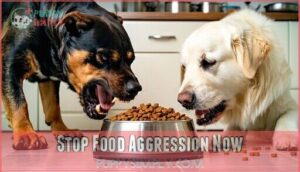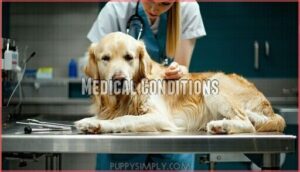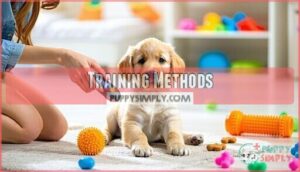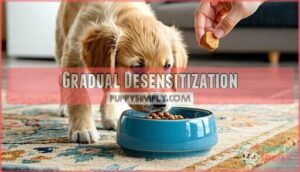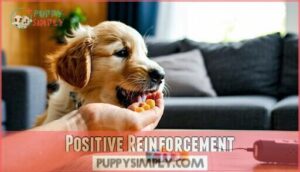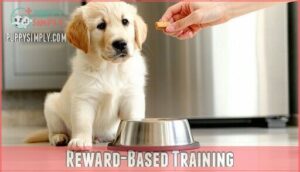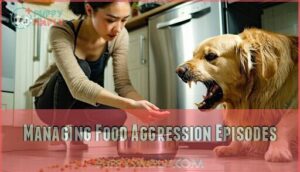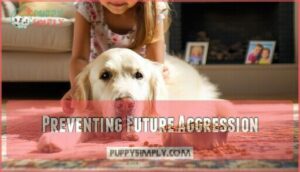This site is supported by our readers. We may earn a commission, at no cost to you, if you purchase through links.
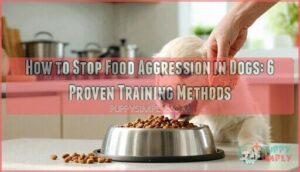 Food aggression doesn’t have to be your dog’s permanent "food fight" mentality.
Food aggression doesn’t have to be your dog’s permanent "food fight" mentality.
You can stop food aggression by implementing gradual desensitization techniques that slowly build trust around mealtime. Start by feeding your dog while standing several feet away, gradually moving closer over weeks as they remain calm.
Use positive reinforcement by dropping high-value treats near their bowl during meals, teaching them that human presence equals good things. Establish consistent feeding schedules and boundaries, never punishing aggressive behavior as this often backfires.
If your pup’s guarding their kibble like Fort Knox, patience and the right training methods can transform them into a mealtime diplomat with surprising effectiveness.
Table Of Contents
- Key Takeaways
- Food Aggression Defined
- Stop Food Aggression Now
- Identifying Aggression Triggers
- Training Techniques for Prevention
- Managing Food Aggression Episodes
- Preventing Future Aggression
- Frequently Asked Questions (FAQs)
- What other breeds are prone to food aggression?
- What should I do if my dog displays severe food aggression?
- Is food aggression a sign of dominance?
- Are there any medications that can help calm my dog?
- Can multiple dogs eat together safely?
- How long does training typically take?
- Are certain dog breeds more prone?
- Should I change my dogs diet?
- What if aggression returns after training?
- Conclusion
Key Takeaways
- You’ll need to gradually desensitize your dog by starting several feet away from their food bowl and slowly moving closer over weeks, rewarding calm behavior with high-value treats to build positive associations with your presence during meals.
- You can’t use punishment or confrontational methods when addressing food aggression – instead, focus on positive reinforcement techniques like hand-feeding, clicker training, and establishing consistent feeding schedules to build trust.
- You should create separate feeding areas for multiple pets, remove competition triggers, and maintain supervised mealtimes to prevent resource guarding behaviors from escalating into dangerous situations.
- You’ll achieve lasting results by combining immediate management strategies with long-term prevention methods, but don’t hesitate to consult professional trainers or veterinary behaviorists for severe cases that could pose safety risks.
Food Aggression Defined
Food Aggression Defined – Introduction
Food aggression occurs when your dog displays defensive or hostile behaviors around their food bowl, treats, or during meal times, which can manifest through growling, snapping, guarding postures, or actual biting directed toward humans or other animals who approach their eating area.
When mealtime becomes a minefield, your dog’s survival instincts have taken control of their bowl.
Understanding this behavioral pattern requires recognizing that food aggression represents a resource-guarding instinct rooted in evolutionary survival mechanisms, where dogs perceive potential threats to their sustenance and respond with protective measures that can escalate from mild warning signals to serious aggressive confrontations if left unaddressed.
Causes of Food Aggression
Understanding food aggression starts with knowing what triggers it in your dog’s world.
Genetic predisposition plays a role, as some breeds naturally exhibit stronger resource guarding instincts.
Anxiety levels, unmet dietary needs, and learned behavior from past experiences can transform mealtime into a battleground.
When dogs view food as scarce, their survival instincts kick in, creating defensive behaviors around their bowls.
Recognizing these behaviors early can help prevent escalation, as vocal cues are important indicators of a dog’s discomfort, and addressing them is crucial for a dog’s well-being and to prevent aggression.
Signs of Food Aggression in Dogs
Your dog’s body language tells the whole story when food aggression strikes.
Watch for stiff body posture, raised lips, and intense staring that screams "back off."
These possessive behaviors signal resource guarding in action.
You’ll notice your pup hovering protectively over their bowl, growling when approached, or even snapping.
Recognizing these warning signs helps you address dog food aggression before it escalates, which is crucial for maintaining a safe environment and preventing further possessive behaviors.
Effects on Dog Behavior
Food guarding triggers cascading behavioral changes that extend far beyond mealtime, elevating your dog’s anxiety levels and disrupting normal social interactions with family members and other pets.
This aggressive dog behavior impairs cognitive function, creating heightened emotional responses that manifest as resource guarding, territorial displays, and decreased trust.
Understanding these interconnected effects helps you recognize when to stop food aggression before it worsens, which is crucial for maintaining a healthy and trust-based relationship with your dog.
Stop Food Aggression Now
When your dog’s mealtime becomes a battlefield, immediate action prevents resource guarding from escalating into dangerous territory.
Professional intervention often becomes necessary when canine anxiety drives aggressive behaviors, particularly in multi-dog homes where competition intensifies the problem. The diet impact on behavior can’t be overlooked, as nutritional deficiencies may contribute to food guarding tendencies.
5 Immediate Steps to Stop Food Aggression:
- Separate feeding areas – Create individual spaces for each dog
- Hand-feed meals – Build trust through controlled food delivery
- Practice "wait" commands – Establish respect before meals
- Remove high-value treats – Eliminate competition triggers temporarily
- Consult professionals – Seek expert dog aggression training guidance
Identifying Aggression Triggers
You can’t solve food aggression without understanding what sets your dog off in the first place.
Identifying specific triggers, whether they stem from environmental factors, past experiences, medical conditions, or inadequate training methods, provides the foundation for implementing effective behavioral modifications.
That address the root cause rather than merely treating the symptoms, is crucial for a successful outcome, and it requires a thorough understanding of what drives your dog’s behavior, including environmental factors.
Environmental Factors
Your dog’s surroundings play a major role in triggering puppy food aggression and food bowl aggression.
Resource Availability becomes scarce when Multiple Pets compete for meals, while busy Feeding Location areas with high Noise Levels create stress.
Child Interaction near food bowls often escalates tension.
To stop food aggression effectively, relocate your dog’s meals to quiet, separate spaces away from distractions and other animals, addressing triggers like these, along with consistent management plans, is essential for long-term success.
Past Experiences
Your dog’s history shapes their relationship with food more than you might realize.
Your dog’s past experiences leave invisible scars that surface every time they see their food bowl.
Trauma history from previous households, lack of early socialization, or resource scarcity can trigger intense food bowl aggression. Consider these painful realities:
- Abandoned dogs who fought for scraps on the streets
- Puppies separated too early from their mothers
- Dogs from hoarding situations with limited meals
These experiences create lasting dog behavior issues requiring patient dog training tips and an understanding of the dog’s trauma history.
Medical Conditions
Your dog’s sudden aggression might stem from medical conditions like thyroid imbalance, dental problems, or neurological disorders.
Pain management is essential, as discomfort during meals can heighten canine aggression. Digestive issues or organ dysfunction may also alter dog eating habits.
Addressing these dog behavior issues starts with a vet visit, ensuring proper care before applying dog training tips to manage food aggression effectively. This behavior is a form of resource guarding and can cause stress in the household, related to canine aggression and resource guarding issues.
Training Methods
Poor training approaches can actually trigger resource guarding behaviors, making your dog’s aggressive feeding behavior worse rather than better.
Inconsistent methods, punishment-based techniques, and rushed timelines often backfire, creating anxiety around mealtimes and undermining your dog’s confidence.
Training mistakes that escalate canine aggression:
- Punishment-based corrections – Scolding or alpha rolls increase fear and defensive responses
- Inconsistent timing – Mixed signals confuse dogs and prevent effective impulse control development
- Skipping counter conditioning – Rushing without proper desensitization work fails to address root causes
Smart dog training advice focuses on clicker training and confidence building to manage food aggression effectively, transforming problematic dog eating habits through patience and positive reinforcement rather than confrontation.
Training Techniques for Prevention
You can prevent food aggression before it becomes a serious problem by implementing specific training techniques that address your dog’s relationship with food and mealtime interactions.
These preventive methods, which include gradual desensitization, positive reinforcement, consistent boundaries, and reward-based training, establish healthy eating habits while building trust between you and your dog during feeding times.
Gradual Desensitization
Start your desensitization training at a safe distance where your dog shows no stress signals around food.
This safe introduction creates positive associations through controlled exposure, allowing slow progression toward the food bowl.
Watch for calming signals like relaxed body language before decreasing distance.
You might find success using dog training products to reinforce positive behaviors.
This systematic approach helps manage food aggression by building confidence rather than forcing interactions that trigger aggressive feeding behavior.
Early socialization, especially during the critical 3-12 week period, is essential for preventing such issues.
Positive Reinforcement
Reward timing matters most when building positive associations around mealtime, as treats given immediately after calm behavior reinforce the desired response effectively.
Clicker training accelerates shaping behavior by marking exact moments of success, while treat variety maintains your dog’s interest and motivation throughout training sessions.
Using high-value training treats can further motivate your dog during these sessions, creating a positive reinforcement environment that is crucial for their development.
These dog aggression solutions create lasting behavioral changes through consistent positive reinforcement techniques, which are essential for improving your dog’s behavior over time.
Consistent Boundaries
Establishing consistent boundaries creates the foundation your dog needs to understand acceptable behavior around food.
Set clear expectations through predictable routines, ensuring every family member enforces the same rules to prevent food aggression.
Reinforcement consistency eliminates confusion, while avoiding ambiguity helps your dog feel secure.
When everyone follows identical protocols, you’ll effectively treat food aggression through unified household management.
Reward-Based Training
Through carefully timed treat delivery, you’ll create positive associations that transform your dog’s relationship with mealtime.
Clicker training enhances this process by marking exact moments when your dog displays calm behavior, effectively shaping behavior through precise communication.
High motivation levels guarantee consistent progress, while strategic reward placement helps prevent food aggression from developing into serious behavioral issues requiring professional intervention, which can be addressed through precise communication.
Managing Food Aggression Episodes
When your dog displays food aggression, you must respond with calculated precision, maintaining emotional equilibrium while implementing immediate safety protocols that protect both human and canine participants in the household environment.
The management of these acute behavioral episodes requires systematic application of distance-creating strategies, attention-redirection techniques, and professional intervention protocols.
These protocols collectively serve to mitigate immediate risks while preserving the long-term therapeutic relationship between owner and pet.
Stay Calm and Assertive
Your calm demeanor becomes your strongest tool when confronting food aggression episodes, as dogs mirror the energy you project into the room.
Maintain assertive body language with squared shoulders and steady breathing, while using controlled voice tones that communicate leadership without escalation.
This confidence building approach helps prevent food aggression from spiraling, creating space for effective intervention without triggering defensive responses.
Redirecting Attention
When your dog shows food aggression, distraction techniques can break the cycle before it escalates.
Use toy substitution by offering a high-value chew toy while removing the food bowl. Command training with "leave it" or "wait" provides positive interruption opportunities.
Watch for calming signals like lip licking or yawning, which indicate your redirection methods are working to treat food aggression effectively.
Safe Distance and Barriers
Physical barriers create safe zones between you and your dog during feeding time, preventing resource guarding incidents that could escalate.
Baby gates, crate doors, and room dividers serve as effective barrier types for distance training.
Keep children away from feeding areas to guarantee child safety. For added security, consider using specialized safety solutions.
These protective measures provide adequate remedy for managing aggressive episodes while maintaining your dog’s comfort and reducing the need for equitable relief through more intensive interventions.
Professional Help When Needed
Sometimes barriers aren’t enough when aggression escalates beyond your control. Severe aggression cases require immediate professional intervention, as untrained attempts can worsen the situation and create dangerous scenarios for everyone involved.
Understanding escalation patterns can help prevent dog bites.
- Certified behaviorist consultation for complex cases involving multiple triggers
- Veterinary consultation to rule out underlying medical conditions causing aggression
- Medication options may be necessary for extreme cases under veterinary supervision
- Specialized training programs designed specifically for resource guarding behaviors
- Legal consultation with experienced attorneys if aggression incidents result in injuries requiring legal assistance
Preventing Future Aggression
Once you’ve successfully managed your dog’s immediate food aggression episodes, establishing long-term prevention strategies becomes essential to guarantee the behavior doesn’t resurface.
Implementing consistent daily routines, maintaining supervised feeding practices, identifying and avoiding specific triggers, and continuing socialization efforts will create a stable environment that reduces the likelihood of aggressive responses during mealtime, which is crucial for preventing future aggression and ensuring a stable environment.
Consistent Feeding Schedule
Establishing predictable meal times creates a foundation for behavioral consistency that reduces your dog’s anxiety around food resources.
When you serve scheduled food portions at the same times daily, your pet learns to trust that meals will arrive reliably, which diminishes the drive for resource guarding behaviors that stem from uncertainty about when the next feeding opportunity will present itself, leading to a state of trust.
Supervised Meals
Beyond maintaining regular feeding times, you’ll need to actively monitor your dog’s mealtime environment through safe supervision.
This involves controlled feeding that requires your presence to observe body language and intervene before resource guarding escalates.
Position yourself where you can watch without hovering, allowing natural eating while preventing territorial behaviors, which creates positive associations with your presence during meals, and helps in preventing territorial behaviors.
Avoiding Triggers
Smart dog owners know that prevention beats correction every time.
Identify what sparks your dog’s resource guarding behaviors and eliminate those triggers completely. Create predictable routines around mealtimes, establish safe spaces where your pup feels secure, and minimize competition by feeding dogs separately.
Early socialization helps, but removing known stressors prevents future incidents from escalating into dangerous situations.
Addressing these triggers is key, as anxiety can be a factor in protective aggression.
Ongoing Training and Socialization
Throughout your dog’s rehabilitation journey, ongoing training and socialization remain the cornerstone of preventing resource guarding relapses.
Advanced obedience sessions build confidence while reinforcing positive behavior patterns around food.
Regular family integration exercises guarantee everyone understands consistent boundaries.
Socialization importance can’t be overstated—exposing your dog to various situations gradually strengthens their emotional stability and reduces aggression triggers long-term.
Frequently Asked Questions (FAQs)
What other breeds are prone to food aggression?
Guarding breeds like German Shepherds, Rottweilers, and Dobermans often show food aggression.
Terriers, resource-guarding Labs, and rescue dogs with unknown histories also display this behavior.
However, any dog can develop food aggression regardless of breed.
What should I do if my dog displays severe food aggression?
Immediately consult a professional dog trainer or veterinary behaviorist.
Don’t attempt DIY fixes with severe cases – you’ll risk dangerous bites.
Meanwhile, feed your dog separately from other pets and family members for everyone’s safety.
Is food aggression a sign of dominance?
Don’t bark up the wrong tree—food aggression isn’t about dominance.
It’s resource guarding, an instinctive behavior where dogs protect valuable items.
Your pup’s simply worried someone will snatch their meal, not trying to rule the roost.
Are there any medications that can help calm my dog?
Yes, your veterinarian can prescribe anti-anxiety medications like fluoxetine or trazodone to help reduce your dog’s stress levels.
However, medication works best when combined with proper training and behavior modification techniques for lasting results.
Can multiple dogs eat together safely?
Sure, multiple dogs can share meals—if you enjoy refereeing furry food fights.
Start with separate bowls placed far apart, supervise closely, and gradually move bowls closer as they learn peaceful coexistence.
How long does training typically take?
Training duration varies substantially based on your dog’s temperament and severity of issues.
Most dogs show improvement within 2-4 weeks of consistent practice, but complete resolution typically takes 2-3 months of dedicated effort to achieve consistent practice.
Are certain dog breeds more prone?
Like a genetic deck of cards, some breeds carry higher stakes for food guarding.
Terriers, herding dogs, and working breeds often show stronger resource-guarding tendencies, but any dog can develop food aggression regardless of breed.
Should I change my dogs diet?
Diet changes can help reduce food aggression by eliminating competition triggers.
Switch to scheduled feeding times, use puzzle feeders to slow eating, and consider high-quality food that keeps your dog satisfied longer between meals.
This approach can lead to a more peaceful mealtime experience by reducing competition triggers.
What if aggression returns after training?
If aggression resurfaces, you’ll need to backtrack and reinforce training basics immediately.
Don’t panic—setbacks happen.
Identify triggers, increase supervision during meals, and consider consulting a professional trainer for additional strategies.
Conclusion
Transforming your dog’s mealtime from a battlefield into a peaceful dining experience requires patience, consistency, and the right techniques.
Learning how to stop food aggression involves understanding your dog’s triggers, implementing gradual desensitization methods, and maintaining positive reinforcement strategies throughout the process.
Remember that progress takes time, and each small victory builds toward lasting behavioral change.
With dedication to proper training methods, supervised feeding schedules, and professional guidance when necessary, you’ll successfully eliminate food-related aggression and restore harmony to your home.
- https://www.researchgate.net/publication/341323625_Functional_analysis_and_operant_treatment_of_food_guarding_in_a_pet_dog
- https://www.aspca.org/pet-care/dog-care/common-dog-behavior-issues/food-guarding
- https://pmc.ncbi.nlm.nih.gov/articles/PMC8833765/
- https://todaysveterinarypractice.com/behavior/aggression-in-dogs-etiology-signalment-and-management/
- https://www.humaneworld.org/en/resources/resource-guarding-dogs

